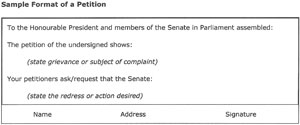70 Form of petitions
-
A petition shall be fairly written, typed, or printed without interlineation or erasure.
-
A petition shall contain a request for action by the Senate or the Parliament.
-
A petition shall be in the English language, or be accompanied by a translation, certified by the senator who presents it to be correct.
-
Every signature shall be written on a page bearing the petition, and shall not be pasted upon or otherwise transferred to it.
-
A petition shall be signed by the petitioners with their names, but may be signed by a person for another in case of incapacity by sickness. A person not able to write may make a mark in the presence of a witness, who shall sign as such.
-
Petitions of corporations may be made under their common seal.
-
No letters, affidavits, or other documents shall be attached to a petition.
Amendment history
Adopted: 19 August 1903 as SOs 73 to 77, 80 and 81 (corresponding to paragraphs (1) to (7) respectively)
1989 revision: Old SOs 78 to 82, 85 and 86 combined into one, structured as seven paragraphs and renumbered as SO 69; language simplified
Commentary

To conform with the standing orders, a petition must be presented in a particular form
The standing orders in relation to the form of petitions have remained the same in substance since their adoption in 1903, having been modelled on similar provisions in the legislative assemblies of Victoria and New South Wales. As a sign of the simplicity and lack of contentiousness of the standing orders, they were adopted without debate in 1903, and have not been amended since.
Although the wording of the standing orders has not changed, the interpretation of the standing orders in recent years has allowed for the presentation of online petitions. See Odgers’ Australian Senate Practice, 12th edition, pp.448–50.